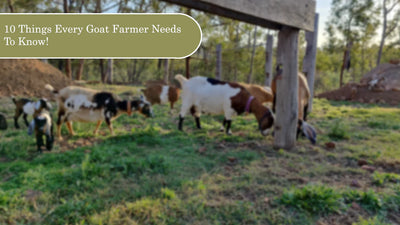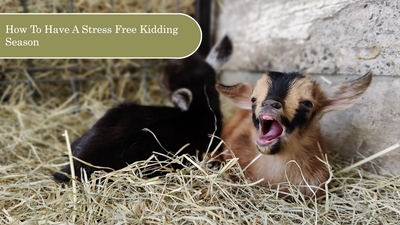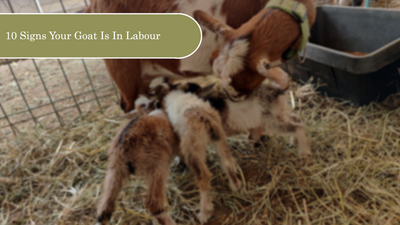As a first-time goat owner, homesteader or hobby farmer, you will no doubt be excited about the prospect of adding some cute furry friends to your farm!
After that initial excitement, comes all the questions and unknowns about what you need to do to be prepared for these new additions - everything from fencing to feeding.
With all the multitudes of information on the web, we have put together our own list of things we think are the basics everyone should know prior to getting started with goats.
- Goat Wellbeing
Being an owner of any animal, your first priority is their well-being. All animals deserve to be treated well and able to live their best life either as a pet, or producer for you on your farm. Here are a few things to keep in mind to make sure you are keeping happy, healthy goats.

- Climbing and jumping! Stumps, rocks, trampolines, if they can jump on it, they will love it.
- Scratching - when they get itchy, they don’t hold back. A sturdy scratching pole or a stone wall will make the perfect scratcher.
- Remove any hazards in the goat yard - sharp fence wire, stickers, hay twine etc, all of these can harm your goat so make sure not to leave any behind.
- Treats! Carrots, bananas, apples and roses make delightful treats for goats. If you’re working to get your goats to trust you, treats go a long way to making that happen.
- Eager milkers - getting your doe used to you and the milking stand well before they need to use it will drastically help when it comes to milking day. If your doe isn’t begging to be milked, you have work to do!
- Goats are herd animals so you must always have a minimum of 2 goats or you’ll have one very loud, very sad goat on your hands.
- Health Management
Goats are not the most robust creatures when it comes to their health. Being ruminants, they have very delicate digestive systems that are easy to upset as well as a high risk of worms due to being pasture raised circumventing their natural browsing nature.

- Gradually introduce new foods so their systems can get used to the new food
- Local vet - having a local vet who is familiar with goats is important to your herd's health, especially if you’re new to goats. The vet you choose should also have the ability to take after-hours and emergency calls or do farm callouts.
- Fecal counts should be done on a 6 weekly basis (more frequent if you are in a high worm load area). Fecal counts tell you how infested your goats are and if they need worming.
- Trim goat hooves every 6 weeks .
- Feeding
Whether you choose to pasture raise your goats or supplement them with pellets, you should keep the following notes in mind.

- Goats are natural browsers, not grazers, which means they would prefer to eat leaves and bark off of trees, rather than eat grass.
- Always have fresh clean water available.
- Robust diet for lactating does - a diet consisting of lucerne pellets, copra meal, lupins, sunflower seeds, leaf forage and 24/7 hay will give your girls everything they need to keep up their condition and milk production.
- Grain should only be given to does late in pregnancy and lactating. Grain for other goats will result in health issues, especially in young bucklings.
- Goat specific minerals need to be always available to your goats. They will self regulate how much of the minerals they need.
- Living Space
Keeping goats requires a little bit of paddock space, and a shelter to protect them from the elements, especially rain, goats hate rain!

- Shelter not only keeps the rain off but also provides a safe place to sleep and somewhere to get out of the heat if you are in a hot climate.
- 25 sq m per goat is the bare minimum you should have. This includes the space for their shelter, water, feed etc.
- Multiple birthing bays will be required if you’re breeding your goats. Not only does a goat love her own space when giving birth, she also needs space away from the rest of the herd to bond with her new babies for at least 5 days.
- Cleaning
Like any animal, it is important to clean out their shelter, water, paddock etc. to make sure they’re not wallowing in their own mess.

- Bedding of hay or sawdust in the goat shelter provides them with a soft clean area to lay and also soaks up any urine, giving them a clean space to lay.
- A sprinkle of baking soda and lime powder under the bedding with help with the smell and keep away flies
- Bedding should be changed a maximum of every 30 days and if you end up with a lice infestation on your hands, don’t forget to change the bedding when you treat the goats.
- Goats drink a lot of water so they need clean, fresh water daily.
- Fencing
Goats are escape artists! They will push any boundary to see if they can get out if the grass looks greener on the other side.

- 6 foot high chicken wire is the best type of fencing you can have for your goats. Wild dogs and dingos can jump up to 6 foot so the higher the fence, the safer your goats.
- Dog wire (with wide squares) is not recommended as goats will get their heads through it, kids can escape, and predators and pests can easily get in.
- Electric fencing is also an option to keep your goats in and predators out. Once they touch it once, they won’t go back and try again.
- Kidding Preparedness
Kidding season is always filled with excitement but there can be anxiety around this too. Goats will 99% of the time be able to give birth with no intervention required, however, if you are needed to assist, you should be as prepared as possible.

- Kidding kit - having a kidding kit is essential to relieving some of the stresses that come with the birthing process.
- Basic Kidding Kit: gloves, towels, lubricant, scissors, bulb syringe, electrolytes
- Advanced Kidding Kit: gloves, towels lubricant, scissors, bulb syringe, electrolytes, weak lamb (kid) syringe, thermometer, puppy pads, cloths, garbage bags, kettle (for hot sterile water), hair dryer (drying off kids thoroughly in cold weather), anti-clotting agent, kid colostrum, milk replacement, kidding bottle and teats.
- Birthing stall - each doe should have a space where she can give birth and bond with her babies for around 5 days.
- The behaviour of other goats in the herd may change when new kids are introduced - watch carefully to make sure they aren’t in any danger.
- Identification
In Australia, NLIS tags/identification are required to be put on all livestock. You can choose to use an approved tag or tattoo on your goats' ears. These tags help to identify your goat as yours to prevent theft and also to help keep track of where a goat has been during its lifetime. Though ear tags are popular, they have the risk of being ripped out by goats when they are rubbing against a fence.

- Biosecurity Plan
Biosecurity on your farm is important for the health of your goats.

- Keep thorough records of your goats and farm.
- Aim to prevent worm loads, infections, and other health issues rather than just fixing them when they happen.
- Have a quarantine area where you can isolate any unwell goats, or new goats before you introduce them to the rest of your herd.
- If you have an unusual death, it’s best to get a vet to determine the cause of death, so you know if you have an issue on your hands with your other goats.
- Record Keeping
Keeping good records of your herd is vital to having a successful and healthy farm. Though it can seem like a lot of paperwork, you will be grateful in the long run for all of the information you have gathered from day one. For each farm, the information you choose to keep might be slightly different however this gives you an idea of where to start. Here are some of the categories you should keep records of.

- Cost of feed and medications
- Labour signs and how each doe handled pregnancy
- Mothering ability of does (does she take good care of her kids)
- Bloodlines (who is bred with who)
- Worming and vaccination doses and dates
- When new goats were introduced
That sums up the long list of things we think would be helpful to new goat owners. Though the list is quite basic, it will give you a head start on what to look for before bringing home your new goats.
We will aim to dive deeper into each topic under a new blog post so be sure to come back to check it out!





